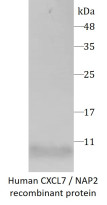ARG70428
Human CXCL7 / NAP2 recombinant protein (Active) (His-tagged, N-ter)
Human CXCL7 / NAP2 recombinant protein (Active) (His-tagged, N-ter) for SDS-PAGE
Overview
| Product Description | E. coli expressed, His-tagged (N-ter) Active Human CXCL7 / NAP2 recombinant protein |
|---|---|
| Tested Application | SDS-PAGE |
| Target Name | CXCL7 / NAP2 |
| Species | Human |
| A.A. Sequence | Ala59 - Asp128 |
| Expression System | E. coli |
| Protein Full Name | Platelet basic protein |
| Activity | Active |
| Activity Note | Determined by its ability to chemoattract BaF3 cells transfected with human CXCR2. The ED50 for this effect is < 0.5 ng/mL. |
| Alternate Names | PPBP; Pro-Platelet Basic Protein; SCYB7; CTAP3; CXCL7; MDGF; LDGF; TGB1; PBP; Platelet Basic Protein; Beta-TG; CTAPIII; LA-PF4; THBGB1; B-TG1; NAP-2; TGB; Connective Tissue-Activating Peptide III; Chemokine (C-X-C Motif) Ligand 7 |
Properties
| Form | Powder |
|---|---|
| Purification Note | Endotoxin level is less than 0.1 EU/µg of the protein, as determined by the LAL test. |
| Purity | > 98% (by SDS-PAGE) |
| Buffer | PBS (pH 7.4) |
| Reconstitution | It is recommended to reconstitute the lyophilized protein in sterile water to a concentration not less than 200 μg/mL and incubate the stock solution for at least 20 min at room temperature to make sure the protein is dissolved completely. |
| Storage Instruction | For long term, lyophilized protein should be stored at -20°C or -80°C. After reconstitution, aliquot and store at -20°C or -80°C for up to one month. Storage in frost free freezers is not recommended. Avoid repeated freeze/thaw cycles. Suggest spin the vial prior to opening. |
| Note | For laboratory research only, not for drug, diagnostic or other use. |
Bioinformation
| Gene Symbol | PPBP |
|---|---|
| Gene Full Name | Pro-Platelet Basic Protein |
| Background | The protein encoded by this gene is a platelet-derived growth factor that belongs to the CXC chemokine family. This growth factor is a potent chemoattractant and activator of neutrophils. It has been shown to stimulate various cellular processes including DNA synthesis, mitosis, glycolysis, intracellular cAMP accumulation, prostaglandin E2 secretion, and synthesis of hyaluronic acid and sulfated glycosaminoglycan. It also stimulates the formation and secretion of plasminogen activator by synovial cells. The protein also is an antimicrobial protein with bactericidal and antifungal activity. |
| Function | LA-PF4 stimulates DNA synthesis, mitosis, glycolysis, intracellular cAMP accumulation, prostaglandin E2 secretion, and synthesis of hyaluronic acid and sulfated glycosaminoglycan. It also stimulates the formation and secretion of plasminogen activator by human synovial cells. NAP-2 is a ligand for CXCR1 and CXCR2, and NAP-2, NAP-273, NAP-274, NAP-2(1-66), and most potent NAP-2(1-63) are chemoattractants and activators for neutrophils. TC-1 and TC-2 are antibacterial proteins, in vitro released from activated platelet alpha-granules. CTAP-III(1-81) is more potent than CTAP-III desensitize chemokine-induced neutrophil activation. |
| Cellular Localization | Secreted |
| PTM | Cleavage on pair of basic residues, Disulfide bond |
Images (1) Click the Picture to Zoom In






